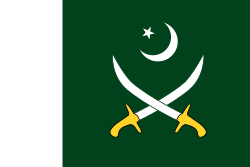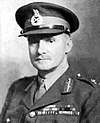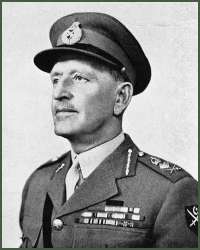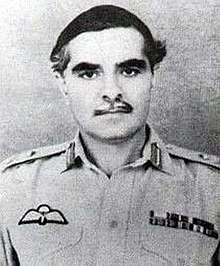Commander-in-Chief of the Pakistan Army
The Commander-in-Chief of the Pakistan Army (reporting name: C-in-C) was normally the highest-ranking officer in the Pakistan Army from the country's independence to 1972.[2]:105 The C-in-C was directly responsible for commanding the army. It was an administrative position and the appointment holder had main operational command authority over the army.
| Commander-in-Chief of the Pakistan Army
پاک فوج کا کمانڈر ان چیف | |
|---|---|
 Flag of the Pakistan Army | |
| Ministry of Defence Army Secretariat-I at MoD[1] | |
| Abbreviation | C-in-C |
| Seat | Army GHQ Rawalpindi Cantonment in Punjab, Pakistan |
| Nominator | Governor General of Pakistan, Prime Minister or President of Pakistan |
| Appointer | Governor General of Pakistan, Prime Minister or President of Pakistan |
| Formation | 15 August 1947 |
| First holder | Gen. Frank Messervy |
| Final holder | Lt. Gen. Gul Hassan Khan |
| Abolished | 3 March 1972 |
| Succession | Chief of Army Staff |
| Deputy | Deputy Commander-in-Chief of the Pakistan Army Chief of General Staff |
Direct appointments to the command of the Pakistan Army came from the British Army Council until 1951, when the first native commander-in-chief was nominated and appointed by the Government of Pakistan.[3]:24
The C-in-C was assisted by a deputy C-in-C until the late 1960s. The last deputy C-in-C was Abdul Hamid Khan, who served until 1969. The C-in-C designation was changed to 'Chief of Army Staff' in 1972, Tikka Khan was the first person to hold the new title. Six men have served as C-in-C, the first two of them were native British and the post was largely akin to the post of Commander-in-Chief of the Indian Army.[4][5][6][7][6][8]
History
Prior to creation of Pakistan from the partition of India on 14 August 1947, the senior military general officer commanding of the Pakistan Army were the ad-hoc appointments made by the Army Board of the British Army.[9]
The appointment was known as Commander-in-Chief who directly reported to the Governor-General who was also under British monarchs.[10]:105 Field Marshal Sir Claude Auchinleck was the last Commander-in-Chief of the undivided British Indian Army who became the supreme commander of India and Pakistan in 15 August 1947 serving till November 30 of the year.[10]:105 On 15 August General Frank Messervy became the first C-in-C of the Pakistan Army.
In 1969, when General Yahya Khan became President of Pakistan, the then deputy commander-in-chief of the army Lieutenant General Abdul Hamid Khan was promoted to full General and was appointed as the 'Chief of Staff of the Army', a newly created post which was akin to Chief of Staff of the United States Army.[6]:contents On 20 March 1972, the commander-in-chief post was renamed as "Chief of Army Staff (COAS)" with Lieutenant-General Tikka Khan elevated to four star rank to be appointed as army's first chief of army staff.[11]:62
The term of the superannuation was then constrained to three years in the office as opposed to four years and was made a permanent member of Joint Chiefs of Staff Committee.[11]:62
Appointees
The following table chronicles the appointees to the office of the Commander-in-Chief since the independence of Pakistan.
Commander-in-Chief, Pakistan Army (1947-1972)
| No. | Portrait | Commander-in-Chief | Took office | Left office | Time in office | Unit of Commission |
|---|---|---|---|---|---|---|
| 1 | General Sir Frank Walter Messervy KCSI, KBE, CB, DSO & Bar (1893–1974) | 15 August 1947 | 10 February 1948 | 179 days | 9th Hodson's Horse | |
| 2 | General Sir Douglas David Gracey KCB, KCIE, CBE, MC & Bar (1894–1964) | 11 February 1948 | 16 January 1951 | 2 years, 339 days | 1st King George's Own Gurkha Rifles (The Malaun Regiment) | |
| 3 | Field Marshal Muhammad Ayub Khan HJ, HPk,MBE (1907–1974) | 17 January 1951 | 27 October 1958 | 7 years, 284 days | 14th Punjab Regiment | |
| 4 | General Muhammad Musa Khan HPk, HJ, HQA,MBE (1908–1991) | 27 October 1958 | 17 September 1966 | 7 years, 325 days | 4th Hazara Pioneers | |
| 5 | General Agha Muhammad Yahya Khan (1917–1980) | 18 September 1966 | 20 December 1971 | 5 years, 93 days | 10th Baluch Regiment | |
| 6 | Lieutenant General Gul Hassan Khan (1921–1999) | 20 December 1971 | 2 March 1972 | 5 years, 93 days | Frontier Force Regiment |
References
- MoD, Ministry of Defence. "Organogram of MoD" (PDF). Ministry of Defence (Pakistan). Ministry of Defence Press. Retrieved 22 July 2017.
- Bajwa, Kuldip Singh (2003). "Kashmir Valley saved". Jammu and Kashmir War, 1947-1948: Political and Military Perspective (googlebooks) (1st ed.). New Delhi, India: Har-Anand Publications. p. 320. ISBN 9788124109236. Retrieved 3 December 2017.
- Harmon, Daniel E. (2008). Pervez Musharraf: President of Pakistan: Easyread Super Large 20pt Edition. ReadHowYouWant.com. ISBN 9781427092038. Retrieved 3 December 2017.
- Cheema, Pervaiz Iqbal (2002). "Defence Administration". The Armed Forces of Pakistan (google books) (1st ed.). New York, U.S.: NYU Press. p. 225. ISBN 9780814716335. Retrieved 25 July 2017.
- Shabbir, Usman (2003). "Command and Structure control of the Pakistan Army". pakdef.org. PakDef Military Consortium. Retrieved 24 July 2017.
- Cloughley, Brian (2016). A History of the Pakistan Army: Wars and Insurrections. Skyhorse Publishing, Inc. ISBN 9781631440397. Retrieved 24 July 2017.
- "Pakistan: Army and Paramilitary Forces". Factba.se. Retrieved 16 December 2013.
- "The Army Chief's". www.pakistanarmy.gov.pk. Archived from the original on 4 December 2013. Retrieved 16 December 2013.
- Lenze Jr (2016). Civil–Military Relations in the Islamic World. Lexington Books. ISBN 9781498518741. Retrieved 21 July 2017.
- Bajwa, Kuldip Singh (2003). "Kashmir Valley Saved". Jammu and Kashmir war, 1947-1948 : political and military perspective (google books) (1st ed.). New Delhi: Har-Anand Publications. p. 350. ISBN 9788124109236. Retrieved 24 July 2017.
- Singh, Ravi Shekhar Narain Singh (2008). "Military and Politics". The Military Factor in Pakistan (googlebooks) (1st ed.). London, UK: Lancer Publishers. p. 550. ISBN 9780981537894. Retrieved 24 July 2017.
.jpg)


.jpg)

